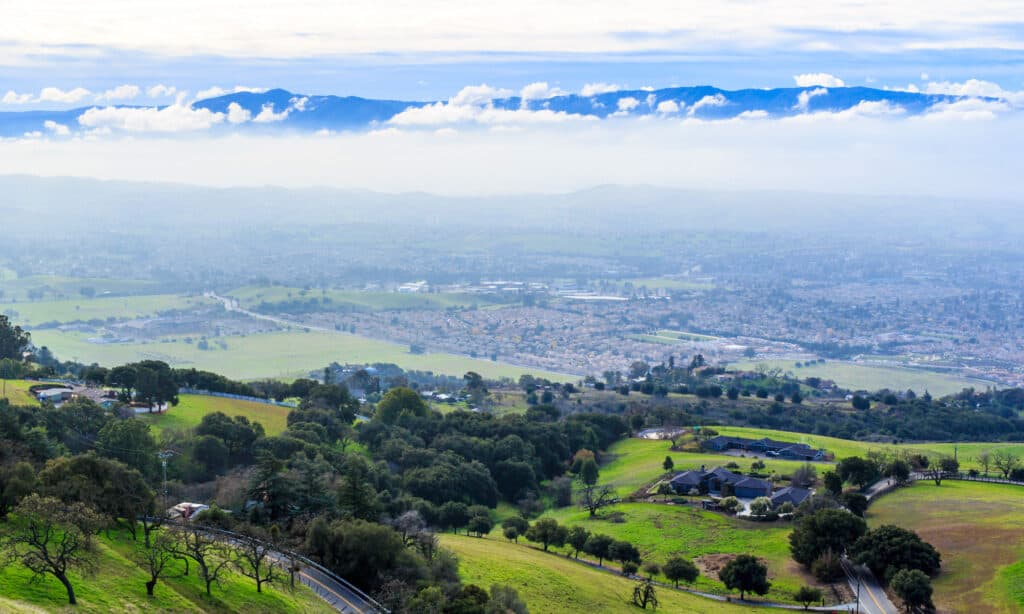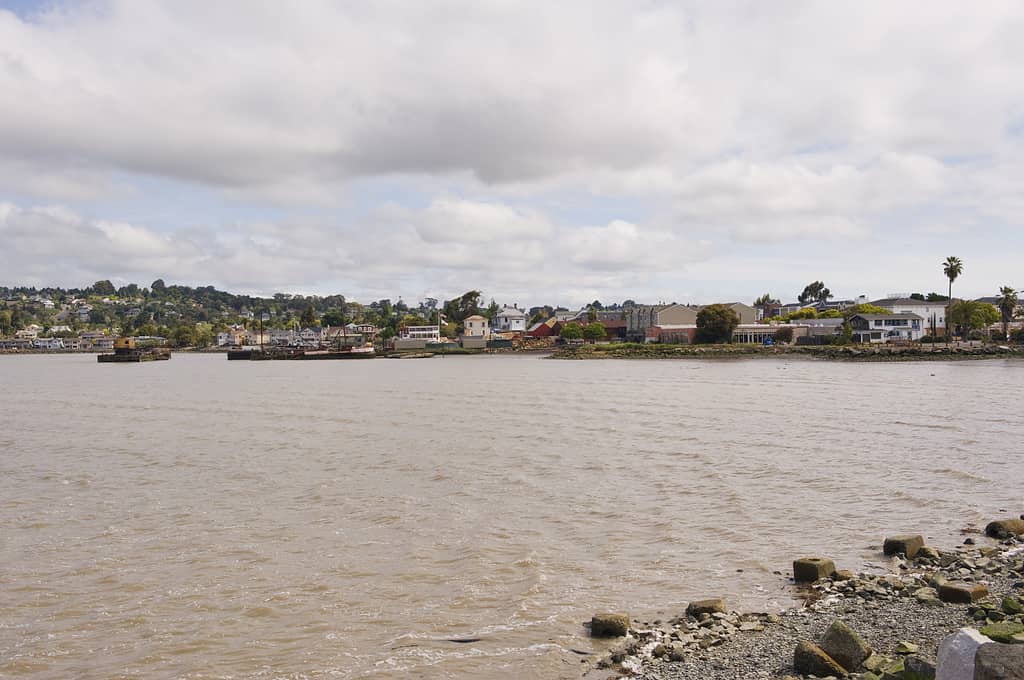Sacramento has been the California state capital since 1854, with a brief break from 1861-1862 due to intense flooding. Before Sacramento was the state capital, four other California cities served as the capital:
- Monterey
- San Jose
- Vallejo
- Benicia
During the 1862 floods in Sacramento, San Francisco served as a temporary state capital. To find out why Sacramento is the California state capital, we must also learn why the other cities didn’t make the cut as a capital.
Why Did Sacramento Become the State Capital
Sacramento became the state capital due to a matter of convenience. After learning of the difficulty of establishing a state capital in other locations, Sacramento allowed legislators to use the city’s courthouse for legislative sessions.
Unfortunately, the original courthouse burned down after less than one year in 1854. A new courthouse was completed in 1855. It contained chambers for the state assembly and senate, and plenty of offices for other state workers. This second courthouse was used until 1869, when the current state capital building was completed. It was used again as a courthouse until 1965. It is now the site of the Sacramento County Jail.
The current California state capital building has remained in the same location since 1869. However, it has had some additions and improvements as the needs of the state have grown.
When and Why Was Monterey the State Capital of California?
Before Spanish colonizers arrived in the area, the area now called Monterey was primarily populated by the Rumsen Ohlone tribe. The Rumsen Ohlone tribe is one of the seven distinct Ohlone tribes still present in the Bay Area.
Monterey holds the nickname of California’s first city, although, technically, San Diego is older. Monterey served as the unofficial state capital of California from 1774 to 1849 as California shifted hands from Spanish colonizers to Mexico after Mexico won its independence from Spain in 1821. Control of the area shifted to the United States in 1849.
As one of the first cities in the state, it became the de facto location for many important events. Many of these were held at Colton Hall, which is now a museum where people can go to learn more about this point in history. This was the site of the new state’s first constitutional convention in 1849. However, this convention appointed San Jose, now a bustling metropolis in Silicon Valley, as the new state capital.
Today, Monterey has a population of around 30,000. The city is popular with tourists due to the Monterey Bay Aquarium, which is one of the largest aquariums in the United States and Canada. It has also attracted many artists due to its inspiring and picturesque views, including Salvador Dali and Percy Gray.

Monterey is popular with tourists due to the Monterey Bay Aquarium, which is one of the largest aquariums in the United States and Canada.
©iStock.com/santalechuga
When and Why Was San Jose the State Capital of California?
San Jose served as the state capital of California for a short time after the capital was Monterey from 1849 to 1851. The capital building was a small building locates where the entrance to the Fairmont Hotel San Jose sits today. In 1854 the California Supreme Court declared that San Jose was the official state capital, despite the fact that Vallejo, Benicia, and Sacramento had already been used as the state capital. However, in 1855, this decision was overturned and it was officially declared that Sacramento was the state capital.
Later, in 1893, an amendment was proposed to bring the capital back to San Jose. However, the city lost the bid because they hadn’t yet put land aside to build a capital building. Eventually, the capital remained in Sacramento where it is to this day.
Today, the San Jose metropolitan area is California’s third largest city. It is also the largest in Northern California and the San Francisco Bay Area, and the 10th largest city in the entire country. It is often referred to as the Capital of Silicon Valley, the important economic area for technology and innovation in the South Bay region of the Bay Area.

San Jose is often referred to as the Capital of Silicon Valley, the important economic area for technology and innovation in the South Bay region of the Bay Area.
©yhelfman/Shutterstock.com
When and Why Was Vallejo the State Capital of California?
Vallejo, a town in the North Bay region of the San Francisco Bay Area, was only the state capital for a short time. It served as the seat of the state from January 5-January 16 in 1852, and then again in between the legislative sessions of 1852 and 1853.
It became the state capital simply because some people didn’t like San Jose’s location. General Vallejo, for whom the town is named, provided land for a state capital in the city. However, at the time, Vallejo was just starting out and didn’t have many businesses or accommodations. The original capital building in the city was a small wooden building with a saloon in the basement. The lack of available services like laundry and stores, and the constant construction in the burgeoning city led legislators to quickly seek a different state capital.
The location of the old state capital building in Vallejo is now a parking lot.
Today, Vallejo is one of the most diverse cities in the country. It has a population of just over 125,000 people.
When and Why Was Benicia the State Capital of California?
Now a seaside town of less than 30,000, Benicia served as the California State Capital for just over a year from 1853-1854. Before colonizers came to the area, Patwin Native Americans lived there.
The city was founded in 1847. After their difficult experiences in Vallejo in 1852 and 1853, legislators were seeking an established city to work in. Unfortunately, bad weather and inadequate accommodations once again caused them to move the capital, this time to its permanent home of Sacramento.
The Benicia capital building is now a museum and state park that has been restored. People can visit to learn more about what it was like to live, work, and legislate in Benicia during the mid-1800s.

Benicia served as the California State Capital for just over a year from 1853-1854.
©iStock.com/jmoor17
When and Why Was San Francisco California’s State Capital?
San Francisco was California’s state capital for a short time between 1861 and 1862 due to extreme flooding.
The event is referred to as The Great Flood of 1862. It happened between December 1861 and January 1862. Over a period of about 6 weeks, nearly 10 feet of precipitation, both rain and snow, fell in California. At the end of this period, a warmer storm came that melted much of the snowpack, adding to the inundation. At least 4,000 people died in California as a whole, many of them in Sacramento. The entire Sacramento valley, an area of a few hundred square miles, was underwater. An important levee broke in the city, adding to the flooding. Drawings from the time show people canoeing as a way to get through the city. Many areas of the city were underwater for several months.
During this time, it was obvious that no legislative work could be done in Sacramento. So, the capital was temporarily moved to the Merchant’s Exchange Building in San Francisco. After the 1862 legislative session, the capital moved back to Sacramento.
Today, San Francisco is an important city and metropolitan area in the United States. However, the population of the actual city is rather low for such a popular city at just over 800,000. General tourism, business conventions, and the tech industry bring many visitors to the city.

In 1862, an important levee broke in the city, adding to the flooding. Drawings from the time show people canoeing as a way to get through the city.
©published by A. Rosenfield (San Francisco) / public domain – License
The California State Capital Today
Today, the capital building in Sacramento serves as the legislative center of the state and also contains a museum where people can learn more about the history of the capital and the state’s legislative processes.
Sacramento now has a population of nearly 525,000 and the entire metropolitan area has a population of over 2.3 million people. When the city was first founded, it was often referred to as the “City of Plains” because of the lack of trees. Today, it is called the “City of Trees” and it has more trees per person than any other place in the world!
It is also called “America’s Farm to Fork Capital” acknowledging its seat in a major American food growing region, meaning much of the farmed food available in the city is local.
The city is among the most diverse in America, and it also has a higher level of integration in neighborhoods than most others in the country. The government is the largest employer in the city, but not only for the State of California. Many people also work for Sacramento County, the federal government, the city of Sacramento, and local school districts.

California Capitol Building in Sacramento.
©iStock.com/bbourdages
The photo featured at the top of this post is © iStock.com/Belyay
Thank you for reading! Have some feedback for us? Contact the AZ Animals editorial team.






